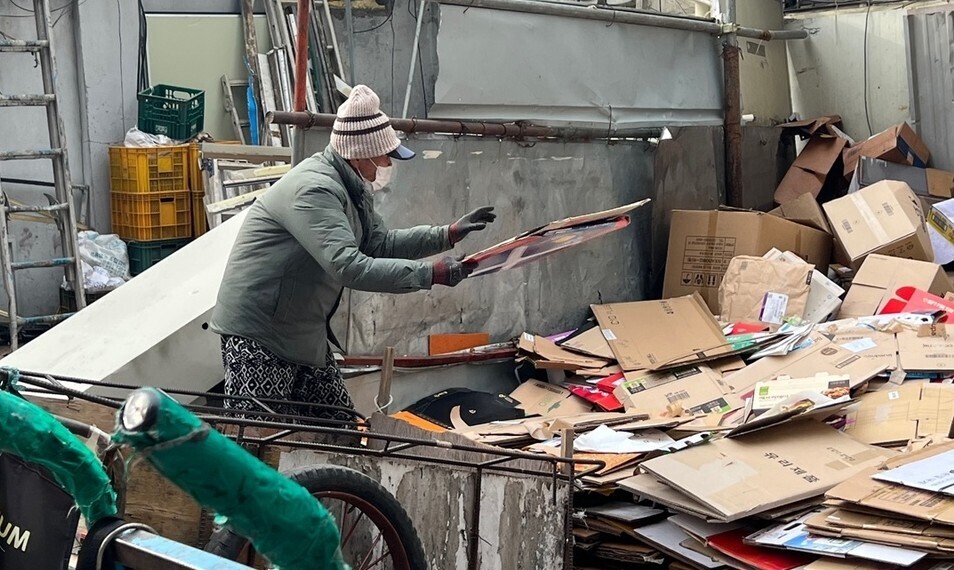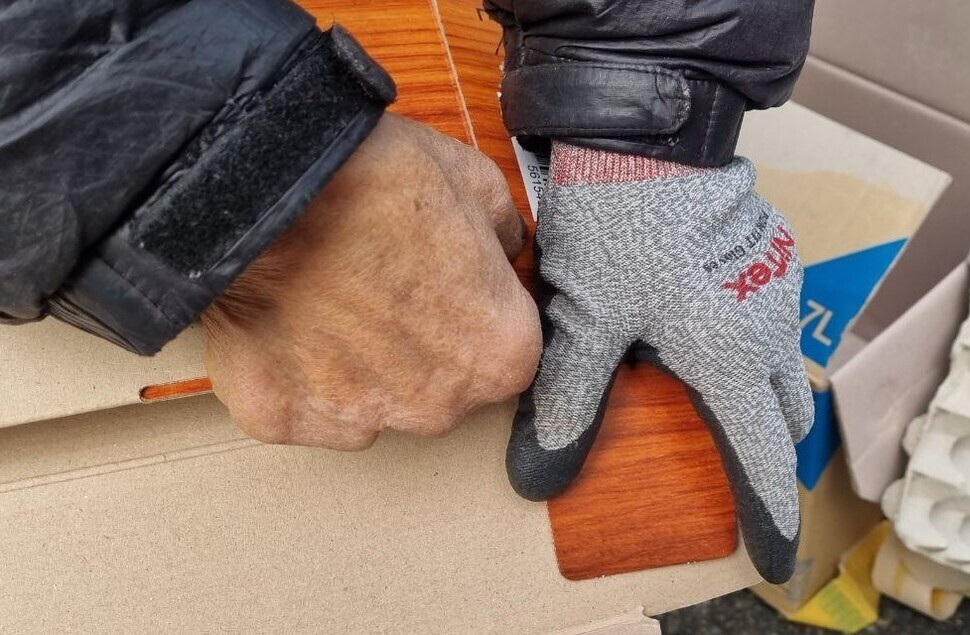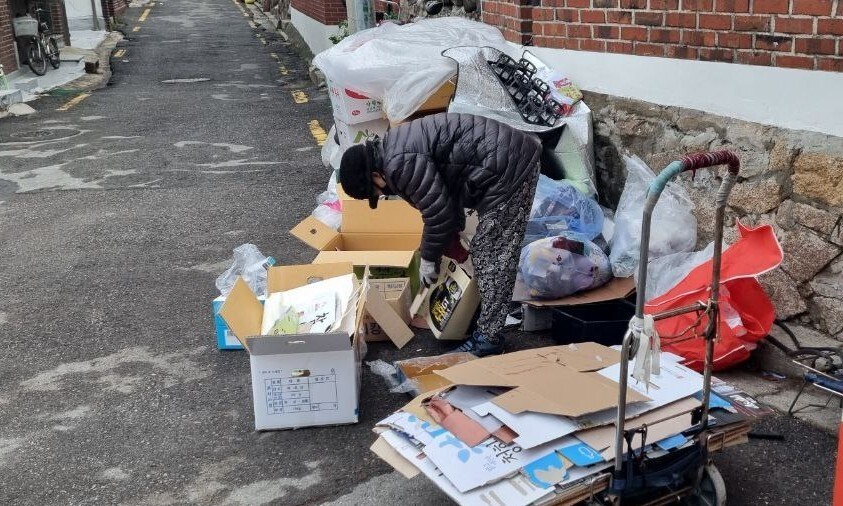hankyoreh
Links to other country sites 다른 나라 사이트 링크
[Reportage] Earning pennies for pounds, Korea’s cardboard-carting seniors face harsh winter

At 6:40 am on Tuesday, a large junkyard in Seoul’s Seodaemun neighborhood weighed a pile of wastepaper brought by a woman named Kang, 75, on her handcart. Her haul totaled 35 kilograms. These days, the price per kilogram of wastepaper is only about 50 won. For all her backbreaking work, she received 1,500 won (US$1.15) in return.
“If the price keeps going down like this, my daily earnings will drop like a stone. Even 70 or 80 won [per kg] would be better,” Kang said.
Kang leaves her house at 6:30 each morning. After loading up previously collected wastepaper, cardboard, plastic and metal onto her cart, she starts her daily rounds by heading to a junkyard around 700 meters away.
After going home and having lunch, she takes a break and then goes back out to the neighborhood to collect more waste.
The next morning, she takes the collected waste back to the junkyard. It has been around three years since Kang has been going to the junkyard seven to eight times a day, without resting on weekends.
Earning a little over 10,000 won a day, she says she earns around 500,000 won a month, which she uses for living expenses and her grandchildren’s pocket money.
The day I spoke to Kang, the snow that had been falling all morning had just stopped. When Kang saw wastepaper in the distance, she hurried to collect it. When crossing the street, however, she didn’t look carefully to check if there was a car coming. She picked up wastepaper for three hours and went to the junkyard four times. After checking the map on my phone, I saw that she had walked 5.6 km, or 8,500 steps.
The day that I shadowed Kang on her rounds, she managed to hit the jackpot. In the morning, she earned a whopping 33,470 won. Although the money she received for 55 kg of wastepaper was only 2,500 won, she was able to earn more than 30,000 won (US$23) thanks to a mound of clothes someone threw away. Clothes go for 670 won per kg.
“That’s the most I’ve ever gotten in history,” she said with a broad smile. With waste cardboard prices down sharply of late, she needs to collect over 20 kg and visit six to seven different junk shops to collect a single 10,000-won bill.
“I don’t think I’m going to have to do that today,” she said.

The nose-dive in waste cardboard prices has brought a deep chill both for the seniors like Kang who collect it and the junk shop dealers who buy it. The price of waste cardboard has dropped as the global economic downturn has reduced demand for paper.
During the “cardboard crisis” that erupted in March and April 2020 when China reduced its waste cardboard imports, the prices paid by cardboard compactors dropped to 55.6 won per kilogram. It underwent a gradual recovery afterward, and a year ago in December 2021 the price reached a high of 152.5 won per kilogram, or nearly triple the level during the crisis.
But after that, it began to drop. Last month, it reached 84 won, or almost half what it had been a year ago. An examination this month found Seoul junk shops to be purchasing waste cardboard at an even lower rate of 40–50 won per kilogram.
This has also created problems for the waste cardboard cycle — from the seniors who collect it to the junk shops, compacting sites and paper plants. As demand drops, surplus cardboard has been piling up at factories and compactors.
According to figures from the South Korean Ministry of Environment (MOE), waste cardboard stockpiles at paper plants averaged 101,000 tons last year; as of June 19 this year, they were up to 192,000 tons. Sensing the urgency of the situation, the ministry relocated the cardboard to public storage in October, reducing the plants’ stockpiles to 144,000 tons. But the situation is still dicey.
“The industry is predicting the price of waste cardboard will continue dropping over the next year,” said Kim Sang-tae, the 46-year-old proprietor of a junk shop in Seoul’s Yeongdeungpo area.
“Once things reach the point where junk shops no longer accept waste cardboard [because of surplus stockpiles], that’s it,” he added. “We could end up seeing uncollected cardboard piling up in front of buildings all over Yeouido.”
Song Ha-yong, a 72-year-old employee at a Yeongdeungpo junk shop, explained, “Typically, the seniors who collect cardboard borrow carts from junk shops or the neighborhood office.”
“When the price of waste cardboard reached 100 won, some of them bought motorized carts to collect the cardboard,” he added.
According to many, the steep drop in waste cardboard prices since then has led to many cardboard-collecting seniors vanishing from the neighborhoods where they were once a common sight.
“After the COVID-19 pandemic started, the number of seniors collecting cardboard fell by half. With waste cardboard prices dropping like they are now, it’s down to one-third,” said a 55-year-old junk shop proprietor surnamed Lee in Seoul’s Mapo District.
The waste cardboard collection market includes some seniors like Kang, who have no other source of income and spend the whole day just gathering cardboard. Others have taken on public jobs or receive benefits but find their earnings too small to survive on.
Most of them received little education and live alone or have no family members to support them. Many have no other option but to continue collecting cardboard, even when they struggle with physical problems.

An 80-year-old surnamed Yang earned 2,300 won at a junk shop in the Yangpyeong neighborhood of Yeongdeungpo on Sunday for selling 45 kg of cardboard — which they had spent over two hours collecting that day — along with other cardboard they had previously gathered.
Yang earns 270,000 won a month through a public job assisting with meals at an elementary school. On the weekend, they supplement that by collecting cardboard.
“If I just stay at home lying around, I get frustrated, so I go out and gather cardboard to get money for medications,” explained Yang, who lives alone.
“I had to take a break because my back hurt, and when I started again last month, waste cardboard prices were down by half,” they added.
Gu Ja-gap, 86, earned 2,000 won for 40 kg of waste cardboard.
“I was working as a meal assistant at a school before, but I got hurt and had to get hip surgery, so now this is all I have,” Gu explained.
“There aren’t any ways for old people to earn money. I’m just trying to make a few cents, but now I’m having a hard time with how little they pay.”
Hearing Gu’s story, an 86-year-old nearby said, “A few months ago, I was knocked out by a cart carrying waste cardboard early one morning, and I had to get an operation to put a metal pin in my chest.”
“I can’t quit this because my basic pension and benefits aren’t enough for me to look after my son, who has cancer,” they explained.
Low wages, dangerous work, and heavily fluctuating waste cardboard prices — these are the conditions facing the seniors who brave the piercing winds. Every day, their lowered heads offer us an up-close glimpse at the face of senior citizen poverty.
By Lee Woo-yun, staff reporter; Seo Hye-mi, staff reporter
Please direct questions or comments to [english@hani.co.kr]

Editorial・opinion
![[Column] Will Seoul’s ties with Moscow really recover on their own? [Column] Will Seoul’s ties with Moscow really recover on their own?](https://flexible.img.hani.co.kr/flexible/normal/500/300/imgdb/original/2024/0513/5917155871573919.jpg) [Column] Will Seoul’s ties with Moscow really recover on their own?
[Column] Will Seoul’s ties with Moscow really recover on their own?![[Column] Samsung’s ‘lost decade’ and Lee Jae-yong’s mismatched chopsticks [Column] Samsung’s ‘lost decade’ and Lee Jae-yong’s mismatched chopsticks](https://flexible.img.hani.co.kr/flexible/normal/500/300/imgdb/original/2024/0512/3017154788490114.jpg) [Column] Samsung’s ‘lost decade’ and Lee Jae-yong’s mismatched chopsticks
[Column] Samsung’s ‘lost decade’ and Lee Jae-yong’s mismatched chopsticks- [Correspondent’s column] The real reason the US is worried about Chinese ‘overcapacity’
- [Editorial] Yoon’s gesture at communication only highlights his reluctance to change
- [Editorial] Perilous stakes of Trump’s rhetoric around US troop pullout from Korea
- [Guest essay] Preventing Korean Peninsula from becoming front line of new cold war
- [Column] The state is back — but is it in business?
- [Column] Life on our Trisolaris
- [Editorial] Penalties for airing allegations against Korea’s first lady endanger free press
- [Editorial] Yoon must halt procurement of SM-3 interceptor missiles
Most viewed articles
- 1Ado over Line stokes anti-Japanese sentiment in Korea, discontent among Naver employees
- 2[Column] Samsung’s ‘lost decade’ and Lee Jae-yong’s mismatched chopsticks
- 3Korean opposition decries Line affair as price of Yoon’s ‘degrading’ diplomacy toward Japan
- 4US has always pulled troops from Korea unilaterally — is Yoon prepared for it to happen again?
- 5Korean auto industry on edge after US hints at ban on Chinese tech in connected cars
- 6[Editorial] Yoon’s gesture at communication only highlights his reluctance to change
- 7[Correspondent’s column] The real reason the US is worried about Chinese ‘overcapacity’
- 8[Column] Will Seoul’s ties with Moscow really recover on their own?
- 9[Photo] Korean students protest US complicity in Israel’s war outside US Embassy
- 101 in 3 S. Korean security experts support nuclear armament, CSIS finds